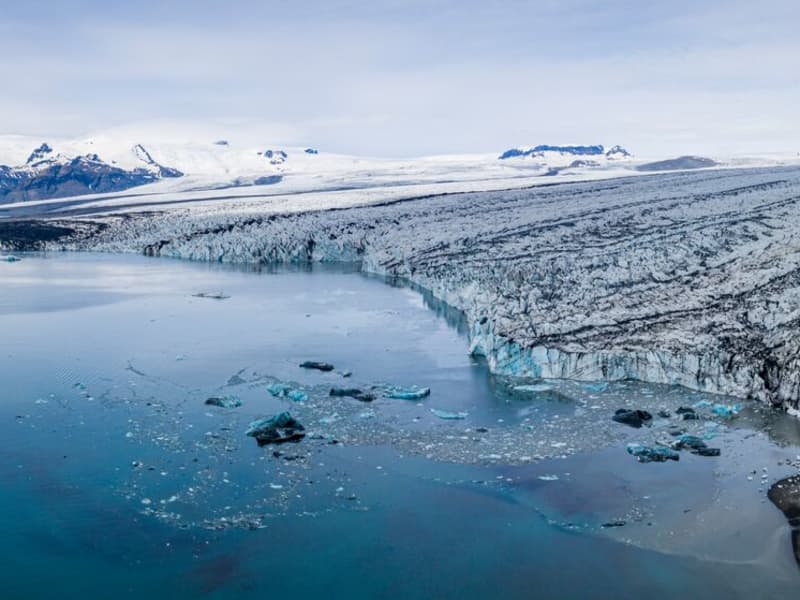
Vatnajökull Glacier
Vatnajökull is the largest glacier in Iceland and the largest glacier by volume in Europe. It covers approx 8 percent of Iceland, measuring an area of 7,700 km² (2021), with an average thickness of 400 m, and the highest point, Hvannadalshnjúkur, measures 2,110 m (6,921 ft.). Vatnajökull has around 30 outlet glaciers flowing from the ice cap, all of which bear a name; glaciers and outlet glaciers all have names that end in "jökull" in Icelandic.
Vatnajökull belongs to the Vatnajökulþjóðgarður (Vatnajökull National Park) and covers a large area surrounding the glacier, including the glacier itself. In 2019, Vatnajökull National Park was inscribed on the UNESCO World Heritage List. The National Park offers numerous exciting sites and is a must for all interested in Geology and beautiful, natural vistas.
View
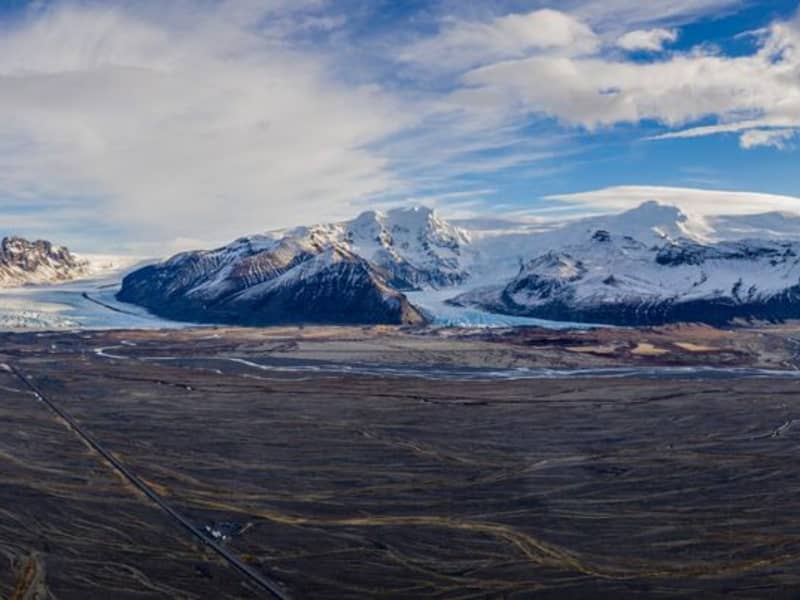
Skeiðarársandur
Skeiðarársandur is a large area of black sands, reaching from Skeiðarárjökull (a part of Vatnajökull) and to the sea. It covers an area of 1300 km² and was formed as the glacial rivers in the area washed material towards the sea. The rivers bring forth material that surfaced during sub-glacial volcanic eruptions in Vatnajökull. Near the glacier, the ground is gravelly and even rocky; as it reaches the sea, it has turned into sand and clay. There used to be little vegetation found on Skeiðarársandur, but in the past decade, a self-sprouted forest of birch trees has been growing lushly in the middle of the area. Skeiðarársandur is a large nesting area for the great skua.
Skeiðarárbrú Skeiðarárbrú is the name of the bridge that crosses the Skeiðará river on Skeiðarársandur, and its opening in 1974 marked the opening of the ring road in Iceland. Skeiðarárbrú is a one-lane bridge made of specifically engineered steel trusses. In 1996 there was a volcanic eruption in Grímsvötn in Skeiðarárjökull, which created massive floods and glacier melting. The hefty amount of floodwaters and house-sized icebergs severely damaged the bridge. All that remains of the original bridge today are two twisted girders by the side of the new road. They form a unique monument to Iceland's natural landscape's lovely but powerful beauty. The bridge has been replaced with a new one due to changes in the water flow underneath the glacier. The river flowing under the new bridge is called Morsá.
View
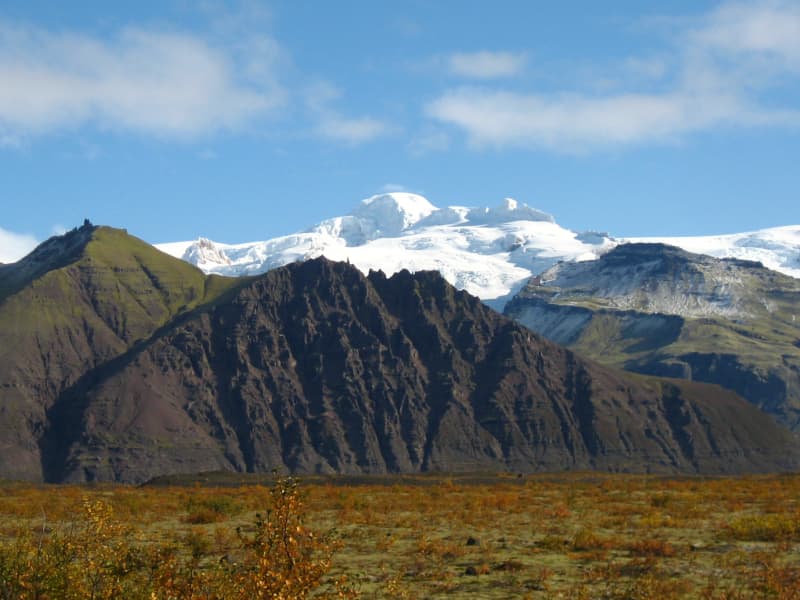
Skaftafell
Scenic nature, favorable weather conditions, and a network of hiking trails make Skaftafell in Vatnajökull National Park an ideal destination to enjoy outdoor activities in Icelandic nature. Short and easy trails lead to the waterfall Svartifoss and Skaftafellsjökull glacier. Still, those who want to reach further out Morsárdalur valley and Kristínartindar mountain peaks are perfect in terms of distance and labor. Skaftafell is also the ideal base camp for those who seek to climb Iceland‘s highest mountain peak, Hvannadalshnúkur.
During the summer months, the national park offers interpretive tours with rangers. Ask for information at the desk or check the park´s website.
Private travel companies operate in Skaftafell and offer guided hikes on the nearby glaciers and mountains. Also on offer are sightseeing flights over the Vatnajökull glacier and other renowned attractions.
Vatnajökulsþjóðgarður
View
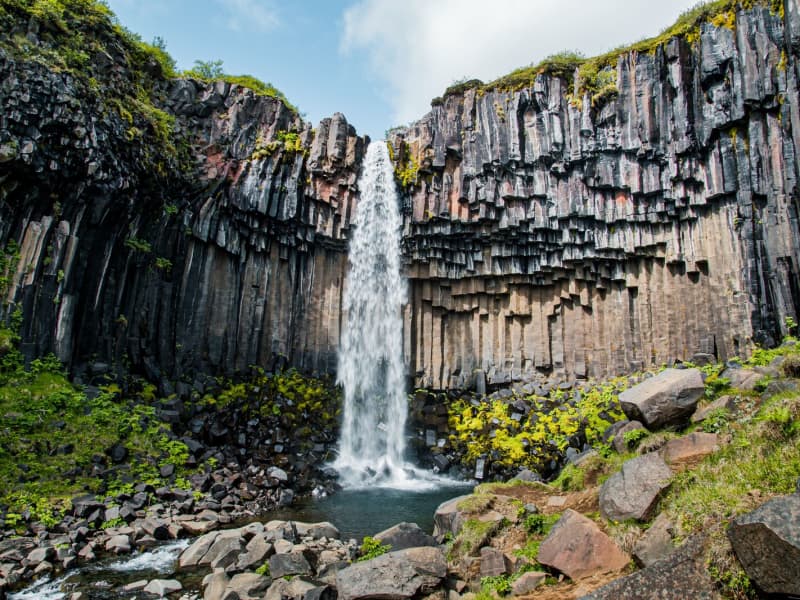
Svartifoss waterfall
Svartifoss is one of the unique waterfalls in South Iceland. It is situated in Skaftafell, which belongs to Vatnajökull National Park. Svartifoss is 20 meters (80ft) high. It is bordered on both sides by tall black basalt columns.
The hike to Svartifoss starts at the Visitor Centre in Skaftafell. You can also find all sorts of information and advice about the area. The hike is about 1.9 km or 45 minutes (one way).
Skaftafell Visitor Centre, Skaftafell
View
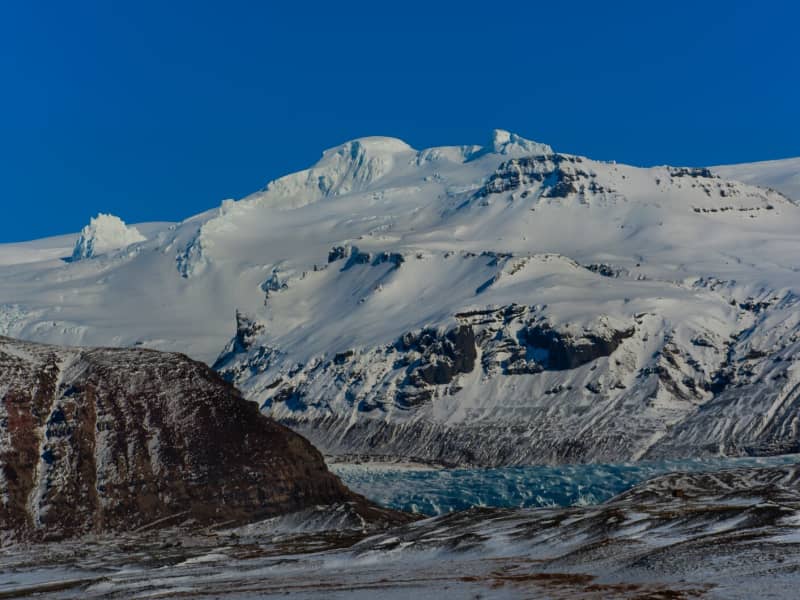
Öræfajökull glacier
Öræfajökull: Iceland’s highest mountainExtending south from the Vatnajökull icecap within Vatnajökull National Park and towering to around 2,110 m (6,922 feet), Öræfajökull is Iceland’s highest mountain. Its height actually varies with the season and the depth of snow and ice, since the peak itself, Hvannadalshnjúkur, is topped by ice which is thickest in spring and thinnest in autumn.
The mountain and surrounding areas offer good skiing in winter and are very popular with walkers and hikers throughout the year.
Vatnajökulsþjóðgarður
View
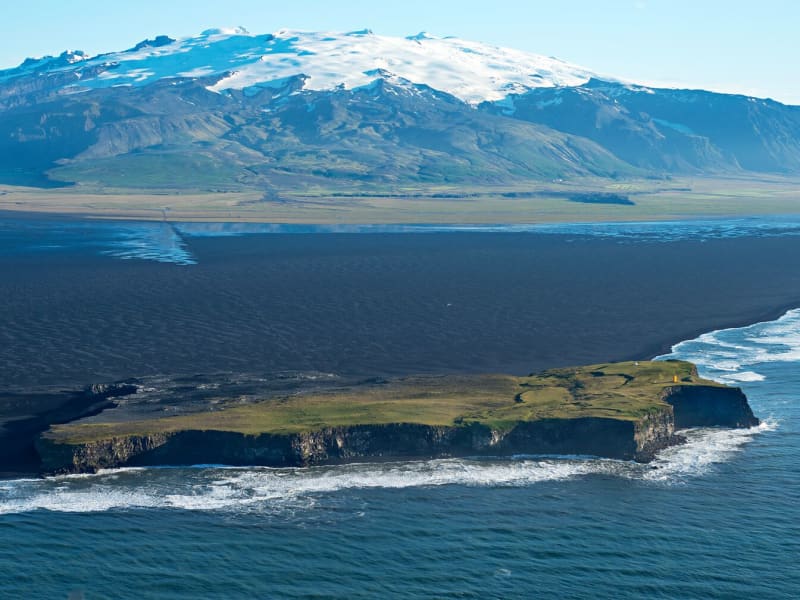
Ingólfshöfði
At the edge of the Atlantic Ocean, Ingólfshöfði is a headland isolated by black sands and perilous rivers from the rest of the mainland.
This historical cape is named after the first settler of Iceland, Ingólfur Arnarson, who spent his first winter there with his family after moving to Iceland, 874-875 A.D.
However, it´s home to thousands of nesting seabirds and gulls, especially puffins and the great skua. Ingólfshöfði is only accessible by organized tours.
View
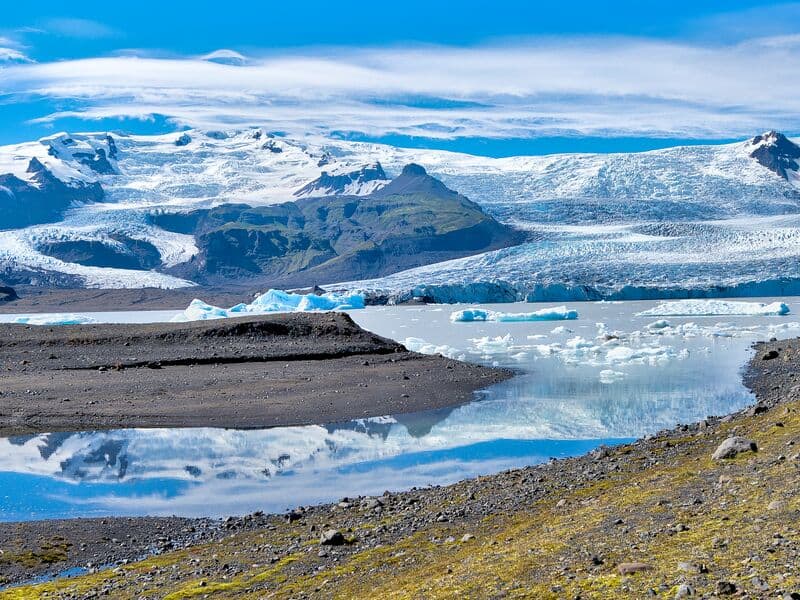
Fjallsárlón Glacial Lagoon
Scenic Fjallsárlón is a glacial lagoon largely within Vatnajökull National Park located around 10 km. west of Jökulsárlón, at the southern edge of Vatnajökull glacier. With the steep glacier tongue, Fjallsjökull coming down from Vatnajökull and all the way into the lagoon makes it a perfectly peaceful place for photos as well as enjoying the untouched nature. Fjallsárlón also offers boat tours on the lagoon as well as a bistro with fresh and tasty refreshments.
View

Jökulsárlón Glacier lagoon
Jökulsárlón is a glacial lagoon by the ring road and was recently designated as a part of Vatnajökull National Park. It's still blue waters are a sight not to be missed, as it is dotted with icebergs from the edge of Breiðamerkurjökull, a part of the Vatnajökull glacier. The lagoon flows through a narrow gateway into the Atlantic Ocean, leaving the spectacular sight of the large chunks of ice on the black sandy beach. In wintertime, the fish-filled lagoon hosts a number of seals, which visit the lagoon for an easy meal. Year-round curious seals can be seen basking on the blue-tinted icebergs. The lagoon is accessible from the beach all year round, and so is the café on the banks of Jökulsárlón. For hikers, a marked hiking trail between Jökulsárlón and Fjallsárlón is recommended as a scenic trip through unforgettable surroundings. During the summer, the national park offers interpretive tours with a ranger. Check for information on the park homepage or social media.
A word of warning - don't jump onto the ice floating in the lagoon. Some tourists think it’s okay to do it, but it is dangerous to play, and the ice can capsize, leaving you stuck beneath it in the ice-cold water. So let's be very careful here.
Please heed the advice of the locals and never step on the ice in the lagoon!
Vatnajökulsþjóðgarður
View
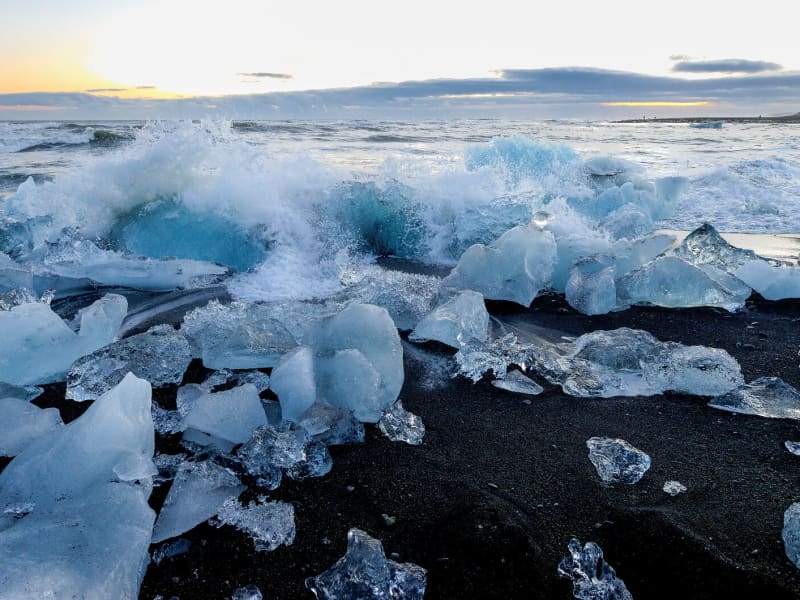
Breiðamerkursandur - Fellsfjara
Next to Jökulsárlón is a less-known attraction within Vatnajökull National Park named -Fellsfjara (Eystri-Fellsfjara on the eastern side of the river and Vestri-Fellsfjara on the western side), which are fields of sand that get strewn with chunks of glacial ice, carried along the river Jökulsá á Breiðamerkursandi, towards the sea and then sent back upon the sands by the tides. The diamond-like pieces of glaciers create a mesmerizing atmosphere in the close mist that often visits the beach. These glistening ice diamonds create an even more spectacular vision in the winter months when the sun comes out and bathes the beach in magical lighting, which reflects off the ice. Waiting around in the darkness for the rising of the sun will be well worth the wait, despite the cold of the Icelandic winter night.
A word of warning: never crawl up on the icebergs and don't choose the ones close to the sea. The photographer must always keep his/her eyes on the sea, or the waves might unexpectedly come in and carry you out to sea.
View
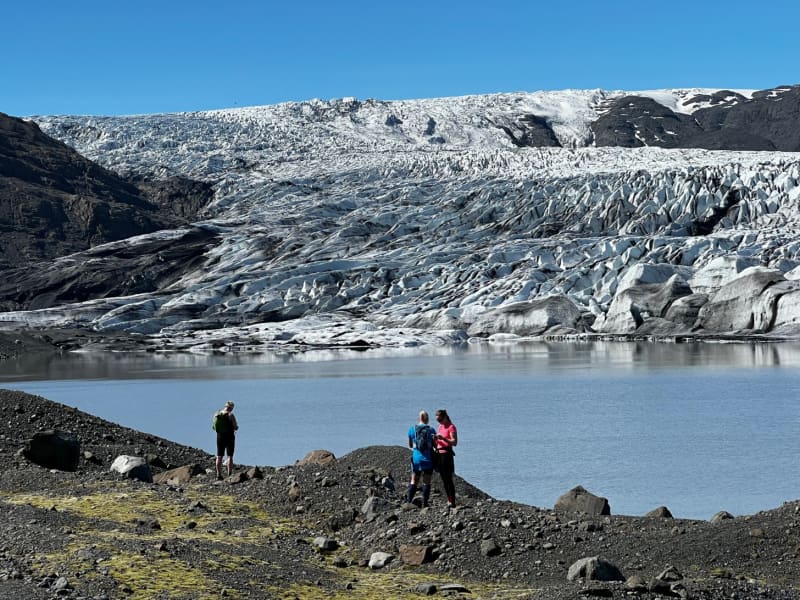
Skálafell – Hjallanes
Skálafell is situated in the exact middle between the glacial lagoon Jökulsárlón and the town of Höfn in Hornafjörður. Skálafell offers access to beautiful, marked walking paths around the Hjallanes area within Vatnajökull National Park offering a mere 4 3-4 hrs hike (8 km circle) to the edge of Vatnajökull glacier. Furthermore, a new walkway bridge over the river Kolgríma opens the hiking area of Heinaberg from Skálafell. This area is very popular when it comes to visiting glacial areas.
View
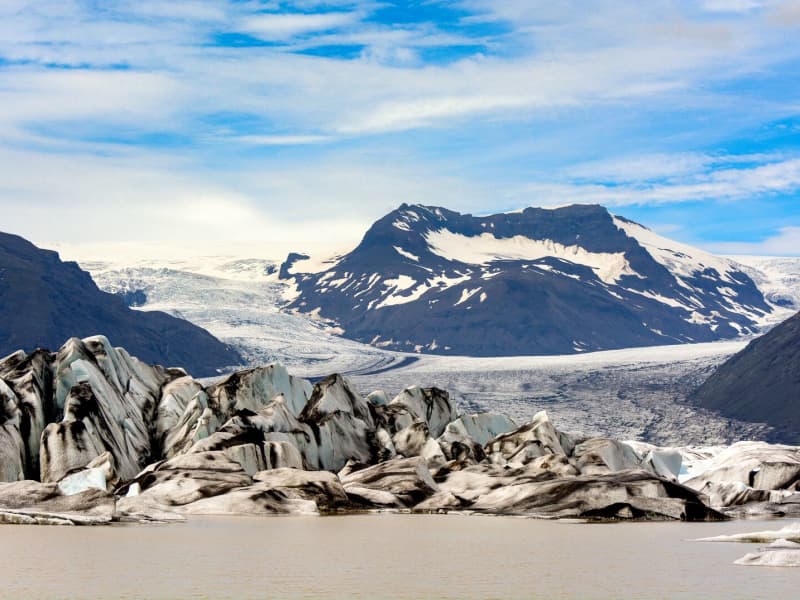
Heinaberg
Heinaberg is a beautiful area that consists of Heinabergsjökull glacier, the glacial lagoon Heinabergslón, where you can go kayaking among the icebergs during summer, and stunning landscape. The Heinaberg area is part of Vatnajökull National Park.
The gorgeous glacial lagoon of Heinaberg, Heinabergslón, is accessible by car and is often studded with large chunks of glacier that break off the Heinabergsjökull glacier. The area offers excellent conditions for hikers, as it has several interesting hiking trails, along which one can see waterfalls, ravines, volcanic intrusions, and even, on a lucky day, a reindeer.
The gravel road from road no 1 to the glacial lake is not in service during the winter months. Therefore, one needs to be aware of changes in road conditions and accessibility.
Vatnajökulsþjóðgarður
View
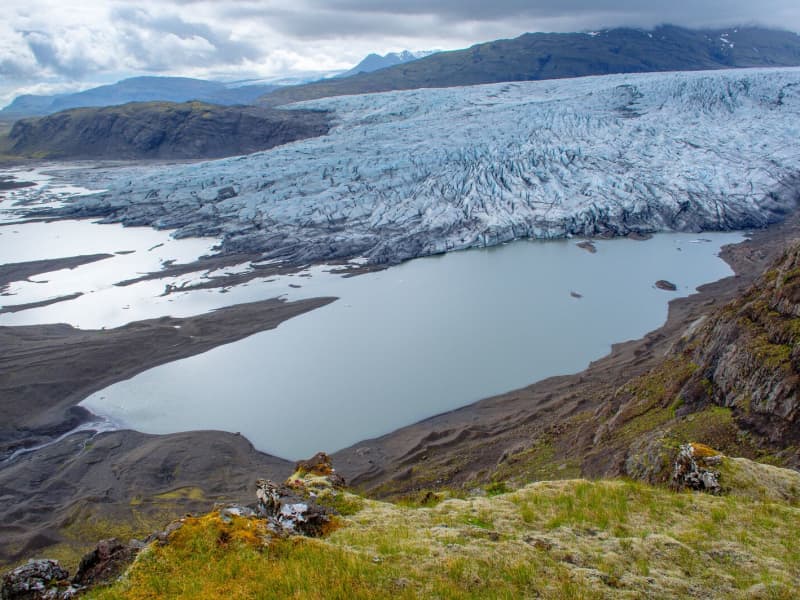
Fláajökull Glacier
Fláajökull is an outlet glacier from Vatnajökull. The area offers spectacular views of the ever-receding glacier that has receded 2 km during the last one hundred years, leaving a glacial lagoon in its wake. The area is, an excellent destination for all interested in witnessing how the glacier movement shapes the surrounding landscape. A marked hiking path connects the Fláajökull area with the Haukafell forestry project.
View
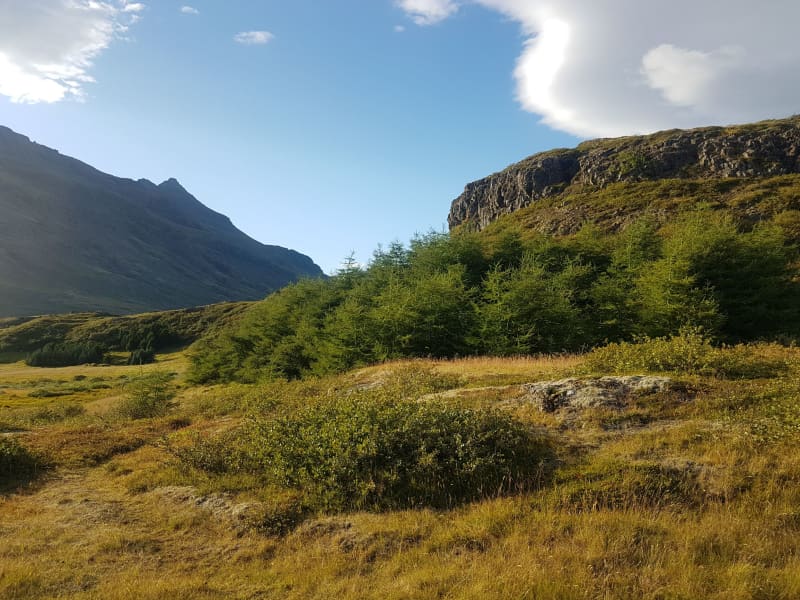
Haukafell
Haukafell is a forestry project that was launched in 1985 and now offers ample shelter to the low-lying, local vegetation, which mostly consists of berry bushes that are ripe for picking in August. The area is situated east of Fláajökull glacier and is a popular outdoor area for the locals. There are various hiking trails to be enjoyed in the beautiful surroundings and the crispy fresh air. From
Haukafell you find a marked hiking trail to Fláajökull glacier, where you cross a recent walkway over the Kolgrafardalsá river. In Haukafell you find a good campsite in a beautiful area.
View
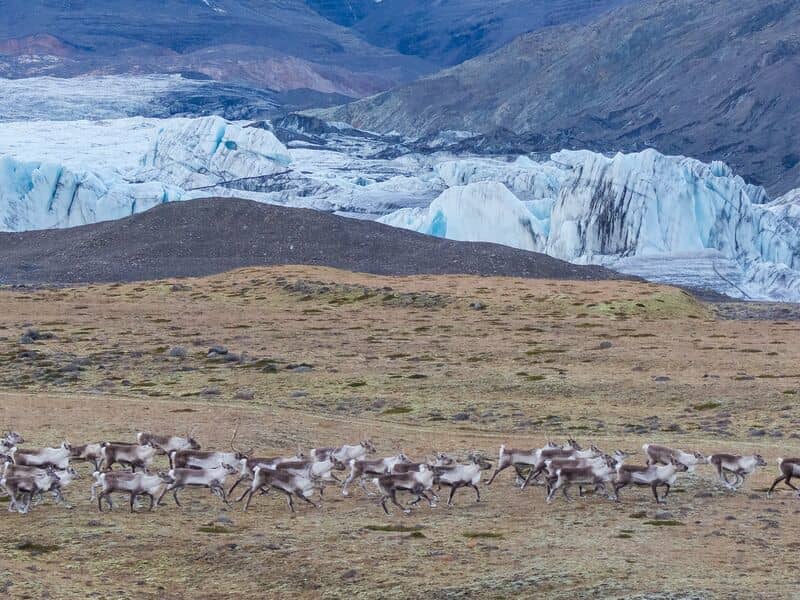
Hoffell
Hoffell is a farmland area characterized by a large outlet glacier named Hoffellsjökull and gabbro rock. Gabbro rock originated deep in the earth but is visible in the area due to the uplift of the area and glacial erosion, which gives the environment a greenish hue in the otherwise dark rocks. The Hoffell area is 15 kilometers from the town of Höfn.
Driving or hiking north from Hoffell along the sands of Hoffellssandur, you will enjoy the spectacular scenery of mountain slopes carved out by earlier glaciers. Along the sands of Hoffellssandur, you will enjoy the stunning scenery of mountain slopes carved out by earlier glaciers. Along the way, a borehole is also constructed to extract geothermal water. Finally, you reach the ice of the glacier tongue, Hoffellsjökull, skirted by the numerous hiking trails of the Geitafell mountain.
The area is partly within Vatnajökull National Park, preserved for outdoor recreation and is rich in vegetation, wildlife, and geological variety. The area’s many hiking trails offer a stunning view of the diverse, beautiful wonders it has to offer.
View
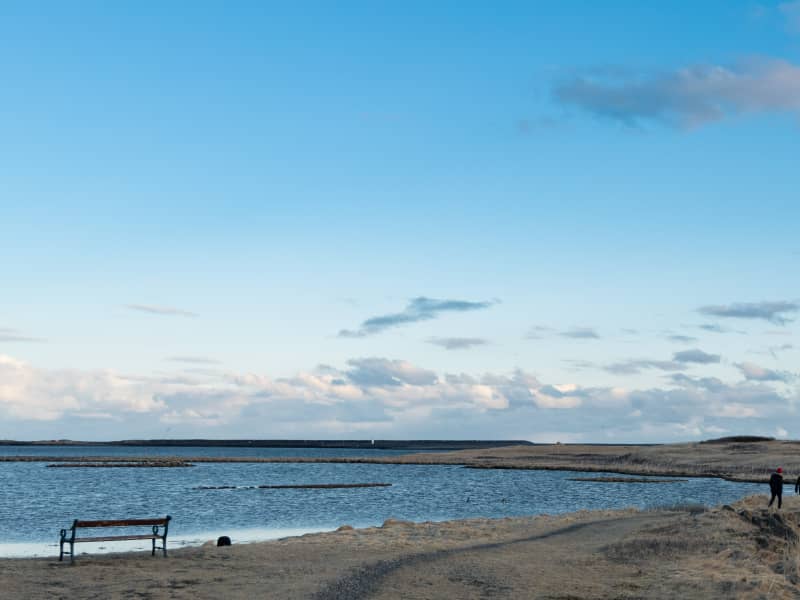
Ósland
Ósland is an island accessible by a manmade isthmus (land bridge) and is situated just a few steps from the harbor area. Ósland was once an island but is now connected to the mainland. It is a conservation area popular for hiking.
There is rich birdlife, and the Arctic Tern is predominant during the nesting season. Ósland is situated just a few steps from the harbor area in Höfn. Walking trails circle the pond, Óslandstjörn, and are along the shore. On the hill, Óslandshæð is a memorial to the fishermen and an information board about the surrounding natural area.
From Ósland, you can follow the nature trail set up to model the solar system – it's been scaled down and has its sizes and distances in proportion. There are also visible impressions of trees in the basalt rock in the area, trees that have been covered by lava a long time ago.
View
Almannaskarð
Almannaskarð is an old mountain road about 10 km to the east of Höfn. Today the southwest ramp is closed for car traffic, as in 2005 it was replaced by a 1300 m long tunnel that curves under a mountain. Since then the area has become a popular hiking path for locals and at the top of the road is a magnificent viewpoint where you can enjoy a panoramic view of the Hornafjörður region as well as the Vatnajökull glacier, on a clear day. It is a charming stop for those who crave the tranquility and natural beauty of the countryside.
View
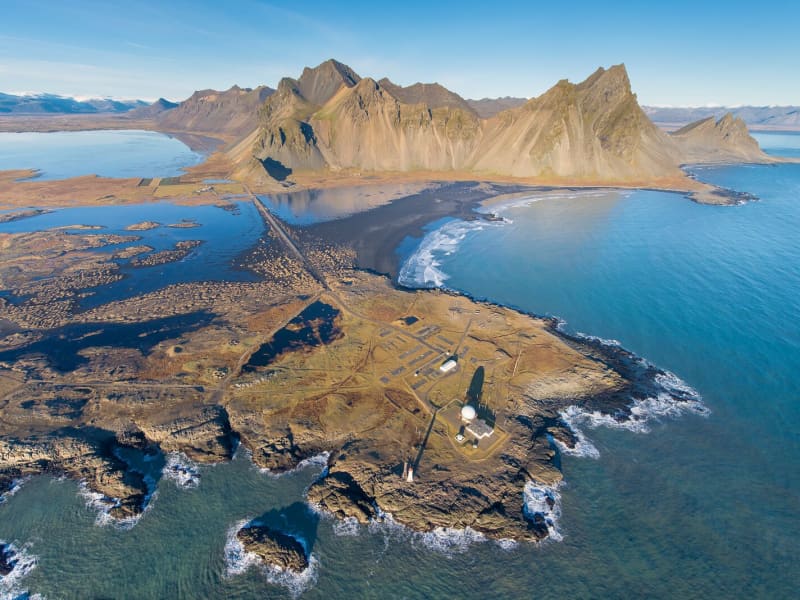
Vestrahorn
In Iceland, one of the first settlement farms was Horn, built by Hrollaugur, son of Rögnvaldur Earl of Møre in Norway. The Hornafjörður Municipality and several natural sites are named after the settlement farm. Horn means the same thing in Icelandic and English.
The area is approximately a ten-minute drive away from Höfn. The Horn area is below Vestra-Horn, a 454-meter-high mountain, and it is an interesting geological site composed of un-stratified plutonic rock, mostly gabbro but with some granophyre. East of the mountain is a strange-shaped outcrop called Brunnhorn that stretches out to sea. Seals also tend to hang out on the stretch of sand, so if you’re lucky, you can also catch a picture of a lazing seal.
During the Second World War, the Horn area became a base for the British army, and later a NATO radar station was set up at Stokksnes, south of Horn. At Stokksnes, you can feel the power of the Atlantic Ocean as the waves hit the rocky shore with massive force.
View
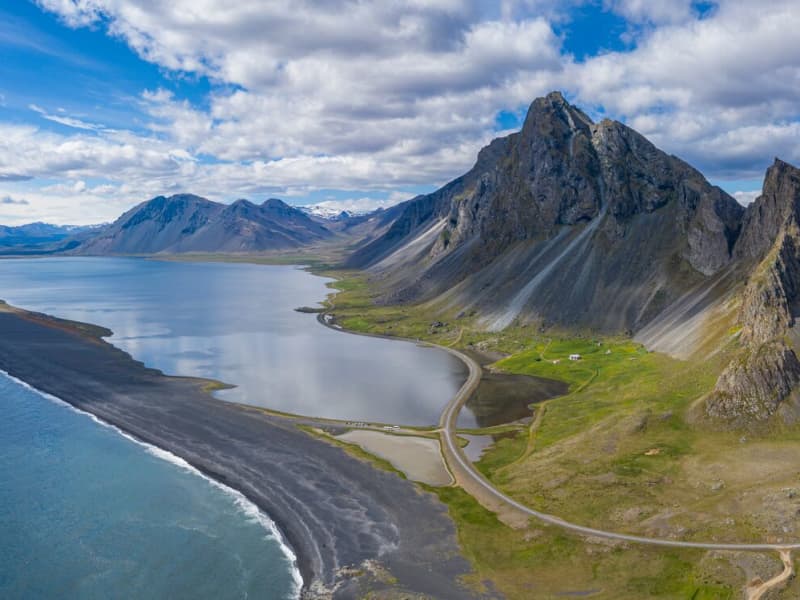
Hvalnes
Hvalnes is a small peninsula with a black pebble beach stretching for a few kilometers. Sitting on its tip is a picturesque old, yellow lighthouse and an old turf farm with the same name as Hvalnes.
The beach stretches for a few kilometers and would make a nice walk, or you can hang out on the beach and enjoy the view. It is an excellent location for bird watching and photography.
View
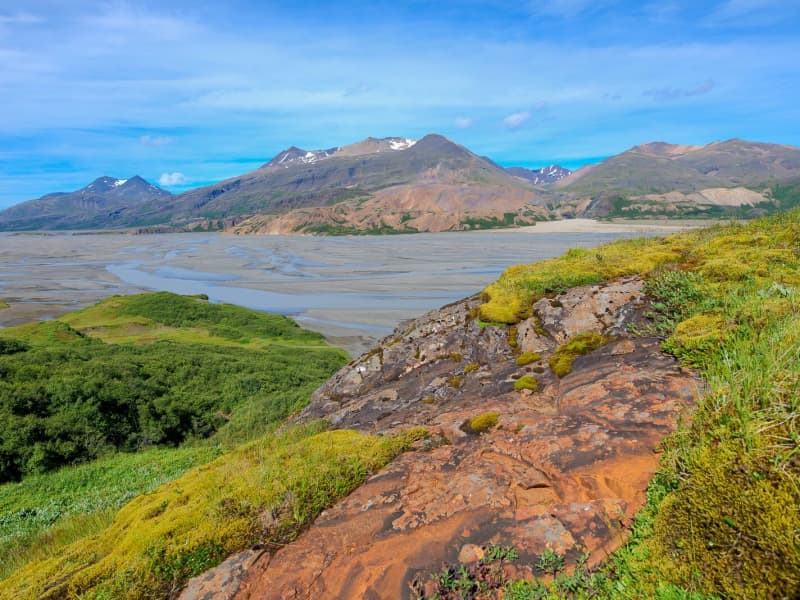
Lónsöræfi
In Lón District, the most eastern area of the Vatnajökull Region, lie the Stafafellsfjöll mountains, also called Lónsöræfi. They dominate the skyline east of the Vatnajökull glacier and have long comprised one of Iceland’s most extensive protected areas. Besides the deep, rugged canyons, the landscape displays a wide range of colors owing to the presence of rhyolite and other colorful rocks. In contrast, there are also lushly vegetated and sheltered valleys offering a very good chance of spotting reindeer. The numerous hiking trails make this area perfect for hiking. Keep in mind that getting there can be very difficult and one should seek advice from a visitor- or information center before attempting to go there.
View
